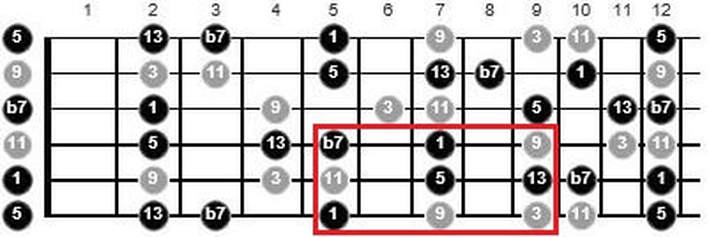If you’re comfortable soloing over major/minor and seventh chords, but things get a little shaky when you have to come up with something to play over a scary chord like a maj11, maj13, or a 13b9#11, these quick hacks will save your ass in almost any ‘jazz contingency’. If you find the idea of playing over chord changes somewhat daunting, these tricks will also simplify the process and provide you with one of the keys to playing over changes in the beginning: having something that’s accessible and sounds good up your sleeve for those situations where blowing up and down a pentatonic scale doesn’t quite cut it.
The Approach
I developed this approach in music
college where we’d often get given a set of chords to improvise over
with one or two chords that didn’t fit in the key, i.e. you couldn’t
just blow through the changes with the same scale, unless you didn’t
mind sounding like shit. So, you’ve got a chord progression with a
couple of nasty chords in it, and less than 24 hours to come up with
something that won’t sound like crap – not enough time to learn any
fancy arpeggios or scales to anywhere near where they’re not going to
sound like you just forced them in there totally devoid of phrasing or
groove, but enough time to learn some simple shapes that will get you
out of jail and perhaps even some theory into the bargain.
Minor 11 Magic
A minor 11 chord contains the intervals 1, b3, (5), b7, (9), 11, the 5 and the 9 being optional. Remember that the 11 is also the 4 and the 9 (should you wish to include it) is also the 2, so there’s nothing to freak out about interval-wise. Take a look at how the notes of Am11 fall on the fretboard:

What may immediately leap out at you is the group of notes that looks suspiciously like box 1 of A minor pentatonic with the addition of the 9 (or 2). You probably won’t want to rip into your stock blues licks here as you’d be missing the point. You now have a six-note scale that could be viewed as either a minor pentatonic with a 9, or a minor scale without some kind of 6. So, to play over a m11 chord, just use the minor pentatonic, add in the 9, and don’t play any well-worn blues licks; in fact, don’t bend any of the strings and it’ll sound completely different.
What do you play over a mM9 chord?
Not a very common chord, I’ll admit, but it’s useful to get you extracting practical information from diagrams such as the one below.

This diagram shows all the available notes that make up an AmM9 on the fretboard. What I did was extract a piece of information I can remember, and which I can whip out the next time I need to play over a mM9 chord. In any one of the blocks above, we have the minor (b3), the major (7), the root, and the 9 in an easy-to-remember format on every string.
What do you play over a m6/9 chord?
Here’s the shape I would learn if I had to whip out something over a m6/9 chord. I chose this one because it looks like A minor pentatonic, I’ll remember it, it’s got two flat thirds in there, plus the 6 and the 9, and it falls nicely under my fingers. If you see another shape or collection of notes in there that’s more to your liking, go with it as the result is the same.

What do you play over 9#5 chord?
Looking at the available notes for this A9#5 chord, another tactic you can use is to go for something symmetrical such as either of the boxes below. Your brain likes this kind of pattern and will remember it easily, allowing you to whip it out over a 9#5 chord, should the need arise.

So, just to recap, the idea here is to extract a useful and memorable piece of information which either falls nicely under your fingers, is a shape you can easily remember, or is symmetrical in some way.
How to Easily Solo Over 13th Chords
13th chords are interesting because if you lay out the notes as we did in the previous example, you’ll see that this is the point where chords meet scales. If you take the intervals from a Maj13 chord, you’ll find that they’re the intervals of the major scale; therefore, you could simply play the major scale over a Maj13 chord. Check it out below.

Remember that 9 = 2, 11 = 4, and 13 = 6.
This also works for other 13th chords.
If you take a Dominant 13 chord and lay it out as we did above, you have the Mixolydian scale/mode:

A m13 chord could also be viewed as the Dorian scale/mode:

A 13#11 chord has the same set of intervals as the Lydian Dominant scale/mode:

And finally, a 13b9 chord could be thought of as the Phrygian Dominant scale/mode:

So there you have it, a variety of ways to play something convincing over advanced or scary chords and sound like you know what you’re doing!



